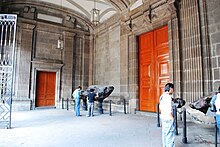Palacio de Minería
The Palacio de Minería is one of the largest and most important secular buildings in Mexico City .
location
The Palacio de Minería is located on Calle Tacuba in the historic center of Mexico City, about halfway between the Cathedral or the Zócalo on the one hand and the Palacio de Bellas Artes or the Alameda Park on the other. Opposite it on the other side of the street is the building of the Museo Nacional de Arte and the equestrian statue of King Charles IV (El Caballito) , which was designed by the Valencia- born architect and sculptor Manuel Tolsá .
history
The viceroyalty of New Spain was one of the largest silver producers in the world from the 16th to the 18th centuries - in the vicinity of cities such as Taxco , Guanajuato , San Luis Potosí , Victoria de Durango and Zacatecas , there were exceptionally high-yield mines, the yields of which came from the Camino Real de Tierra Adentro were transported to Mexico City and registered there before they were shipped via the port of Veracruz to Cuba and then to Spain. Unaware of the approaching Mexican struggle for independence (1810-1821), the Spanish crown under Charles IV decided towards the end of the 18th century to create a central office for mining in the viceroyalty and in 1797 commissioned Manuel Tolsá with the planning and construction management of the Palacio de Minería . Under his direction, the building was completed in 1813 in clear style forms linked to the architecture of the Renaissance . It initially hosted the Royal Mining Seminar (Real Seminario de Minería) and the Royal Mining Court (Real Tribunal de Minería) . The University of Mexico's Physical Institute ( UNAM ) and a state engineering school later found a home here. Today, parts of the huge building are used as a museum (murals from the 19th century) as well as for educational, conference and exhibition purposes.
architecture

The Palacio de Minerías is a square building with a side length of approx. 80 m; it is three-story and has three entrances and a cloister-like inner courtyard (patio) . The two side portals with their side columns - each bearing an architrave with a blown gable - are reminiscent of the late Renaissance and Baroque ; Above them there is a balcony with a balustrade . The three-portal main entrance is elevated by a triangular gable and a smaller building attachment and leads into a foyer in which several iron meteorites are exhibited. The courtyard area behind it is on the ground floor rusticated - arcades with featured three-quarter columns ; the upper floor with its double columns makes a far lighter and more open impression. Behind it, a ground-level passage leads into further rooms, while the two staircases on the left and right lead to the upper floor.
Meteorites
In the entrance hall of the building three approximately 7 to 14-ton sections of in 1852 in are state of Chihuahua found Chupaderos - meteorite on display; smaller pieces were also found. They are all made of iron , which probably came from the core of an asteroid that shattered long ago. The smoothing of the surfaces was created when passing through the earth's atmosphere ; protruding tips and edges were melted away.
Web links
- Palacio de Minería - Photos + Info (Spanish)
- Palacio de Minería - Information (English)
- Website of the Palacio de Minería - photos + information (Spanish)
- Chupaderos meteorite - Photos and information (English)
Coordinates: 19 ° 26 ′ 7 ″ N , 99 ° 8 ′ 22 ″ W.

